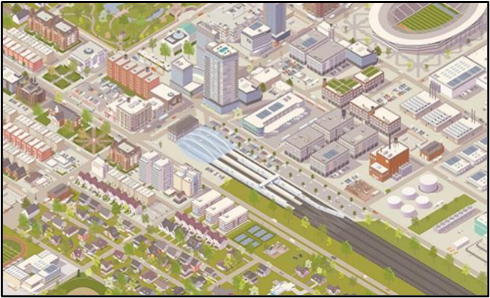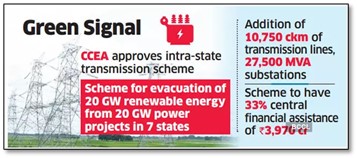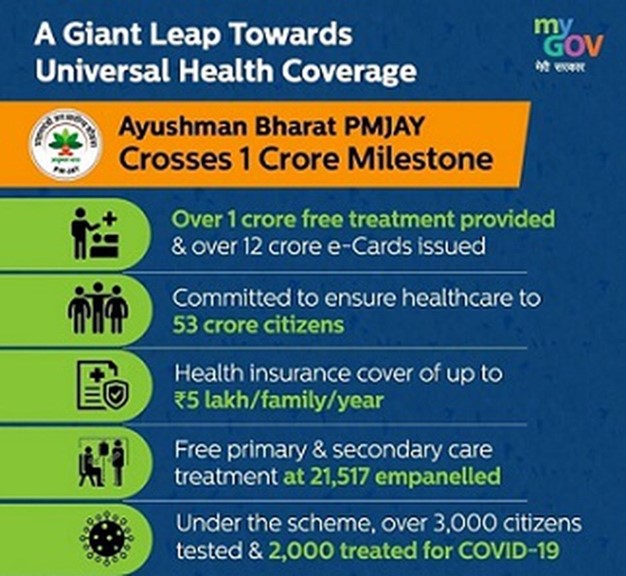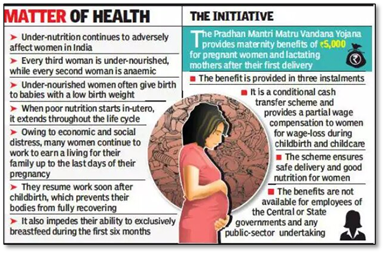Monday, 21st February 2022
Inter-Operable Criminal Justice System (ICJS)
In News
The Union government has approved the Phase II of Inter-Operable Criminal Justice System
About the News
- Government has recently approved implementation of Inter-Operable Criminal Justice System (ICJS) project during the period 2022-23 to 2025-26.
- Phase II of the ICJS project will be undertaken under the guidance of Ministry of Home Affairs and will be implemented by National Crime Records Bureau (NCRB) in association with National Informatics Centre (NIC).
- It will be implemented as a Central Sector Scheme at a total cost of 3,375 crores with active association with the States and Union Territories.
- It is perceived as an attempt towards ensuring effective and modern policing
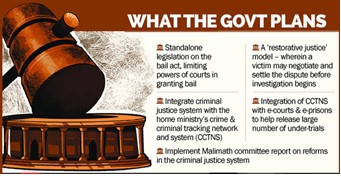
What is Inter-Operable Criminal Justice System (ICJS) project?
- ICJS is a national platform for enabling integration of the main IT system used for delivery of Criminal Justice in the country.
- Unified platform: It seeks to integrate the five pillars of the system viz Police (through Crime and Criminal Tracking and Network Systems), e-Forensics for Forensic Labs, e-Courts for Courts, e-Prosecution for Public Prosecutors and e-Prisons for Prisons.
- Phase-I: Under it the individual IT systems have been implemented and stabilized besides enabling search of records on these systems.
- Phase-II: In second phase the system is being built on the principle of ‘one data one entry’ whereby data is entered only once in one pillar and the same is then available in all other
- Data security: the ICJS system would be made available through a dedicated and secure cloud-based infrastructure with high-speed connectivity.
Why is it important?
- Effective criminal justice system: Interoperability of data and accessibility across all Pillars will build an effective criminal justice system across the country.
- Better record management: Creation of National crime & criminal data search across all Pillars will help in tracing a record from right from registering FIR against suspects to imprisonment of convicts.
- Better reporting: Online MIS dashboard and reporting of FIR/Case/ Case pendency/ Prisons/ Prisoner status-based information will help promote easy investigation, search, case history, judgments provided, and other details pertaining to criminal justice required from time to time.
- Effective crime prediction: Data Analytics of Forecasting/ Predictive Trends in Crimes reported region-wise, category-wise will help in setting parameters for effective management & control of crimes in future.
- Seamless data sharing across all pillars: Common Network Connectivity will promote a robust & reliable network for seamless exchange & interoperability of data between all pillars of ICJS.
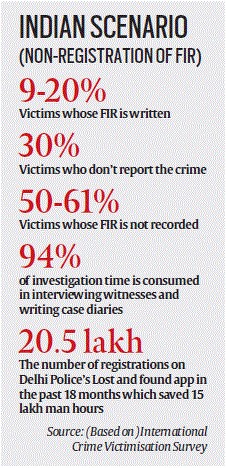
For article related to this topic, refer to:
Sources:
Green Tariff in Electricity
In News
Government plans to have a separate ‘green tariff’ for consumers who wish to procure their entire power needs from renewable energy sources
About the News
- The plan proposes to help electricity distribution companies leverage prevailing low tariffs from solar and wind power projects compared to conventional fuel sources such as coal.
- Once the mechanism is in place, DISCOMs can exclusively buy green electricity and supply it at ‘green tariff’, which will be the weighted average tariff of green energy that the consumer will pay.
- A green tariff is a price structure, or an electricity rate, offered by a local utility and approved by the state's Public Utility Commission that allows eligible customers to source up to 100% of their electricity from renewable resources.
- India’s solar and wind power tariffs had touched a record low in the past few years before recovering due to GST revision.
Motivation behind the plan
- The government has made energy transition and climate action one of its key focus areas, according to Union Budget.
- This is in line with the PM’s pledge at the COP26 summit in Glasgow last November.
- India pledged to meet 50% of her energy needs from renewable energy by 2030 and boost non-fossil fuel power generation capacity to 500 gigawatts (GW) by the end of this decade.
- According to the Central Electricity Authority, the country’s power requirement would touch 817GW by 2030, half of which will be met by renewable energy.
- The buyer’s behaviour in electricity market is shifting from long-term contracts to short-term contracts.
- Green tariffs are a great tool for consumers to access renewable power because of their simplicity and flexibility.
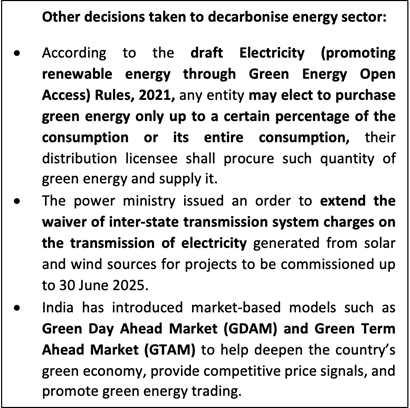
Probable challenges
- Renewable power is dependent upon variable natural factors, such as wind speed and solar irradiation, thereby causing the actual generation to vary from the scheduled generation which eventually create grid insecurity issues.
- So, if the DISCOMS start increasing their contracted renewable capacities, then they would also be needing sufficient conventional power to absorb the deviations happening in green energy generation in order to maintain grid stability.
- The banking regime/regulations are not consistent across the States in India. Banking is storing the surplus renewable power with the DISCOM concerned. There are some States which do not encourage the provision of facility of banking to renewable power developers citing commercial reasons.
- This may be solved by introducing an on-site battery storage facility clause for renewable power plants. Government has already been introducing policy measures for developing energy storage systems in India.
For article related to this topic, refer to:
- https://edukemy.com/current-affairs/gazette/2021-10-25/rules-to-help-renewable-energy-producers
- https://edukemy.com/current-affairs/kosmos/2022-01-22/the-need-for-energy-diversification-in-india
- https://edukemy.com/current-affairs/gazette/2022-02-17/green-energy-corridor
- https://edukemy.com/current-affairs/gazette/2021-10-21/renewable-energy-investment-attractiveness-index
- https://edukemy.com/current-affairs/gazette/2021-10-22/energy-storage-in-power-sector
- https://edukemy.com/current-affairs/gazette/2021-07-23/renewable-energy-certificate-rec-mechanism
Sources:
Neutrino Observatory Project
In News
Tamil Nadu has made clear to the Supreme Court that it does not want the Indian Neutrino Observatory (INO) to be set up in a sensitive ecological zone in the Western Ghats.
About INO
- The India-based Neutrino Observatory (INO) Project is a multi-institutional effort aimed at building a world-class underground laboratory with a rock cover of approx. 1200 m for non-accelerator based high energy and nuclear physics research in India.
- A neutrino is a fundamental elementary particle, and atmospheric neutrinos can be studied when solar radiation hits the earth’s atmosphere.
- The project is jointly funded by of Atomic Energy (DAE) and the Dept. of Science and Technology (DST), Govt. of India.
- It involves construction of an underground laboratory and associated surface facilities at Bodi hills of Theni District of Tamil Nadu. The proposed site is spread across Kerala and Tamil Nadu.
- The initial goal of INO is to study neutrinos.
- More than 50 scientists from about 15 Institutes and Universities in India have come together to form the National Neutrino Collaboration group (NNCG).
- The project was due to be completed in 2015 but met first resistance for the proposed site in 2009 from the Union environment ministry.
- If completed, the project will have a 50 kilotonne magnet, the world’s biggest.
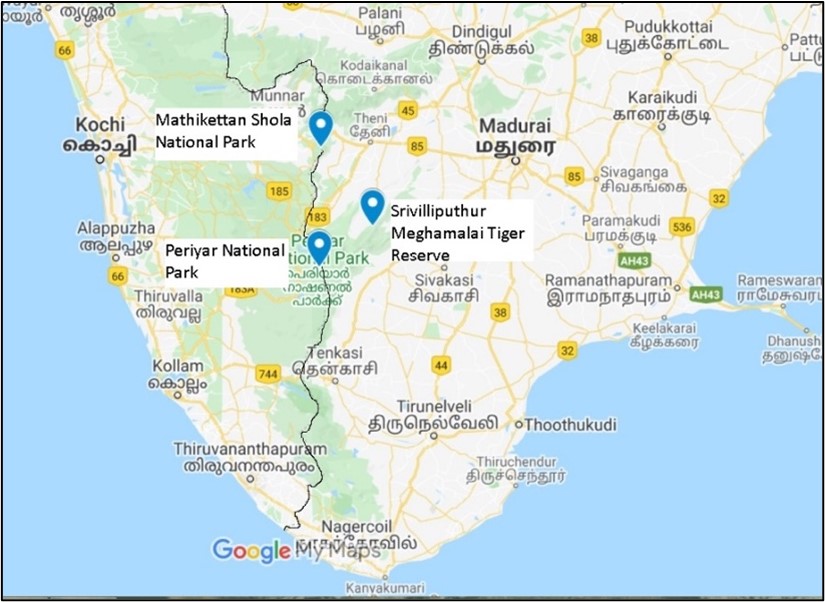
Ecological Concerns
- The project in question falls exactly on the hill slopes of the part of the Western Ghats, which contains a significant tiger corridor, namely the Mathikettan-Periyar tiger corridor.
- This corridor links the Periyar Tiger Reserve to the Mathikettan Shola National Park in Kerala along Tamil Nadu- Kerala border.
- The proposed project area also ecologically links to the eastern habitats, where Srivilliputhur Meghamalai Tiger Reserve is located in Tamil Nadu. It hosts tigers from this region and helps in genetic dispersal.
- The area, is a significant watershed and catchment zone for the rivers Sambhal and Kottakudi and hosts many endemic species of flowering plants, fish, amphibians, reptiles, birds, mammals and invertebrates other than large numbers of elephants and tigers.
- Tamil Nadu state government filed an affidavit in SC explaining that though the experiments in the observatory itself would be conducted a kilometre underground, massive blasting, activities like transportation, excavations and tunnelling among others, would jeopardise the ecological sustainability of the zone, deep in the Western Ghats.
- The affidavit clarifies the State’s position in an appeal pending in the Supreme Court against the National Green Tribunal’s (NGT) decision to uphold the environmental clearance.
- Experts involved in the project have stated that it poses no risk to the tigers or the corridor as the tunnels and the laboratory would lie deep underground, even if in the designated tiger reserve.
For articles related to the topic, refer:
- https://edukemy.com/current-affairs/gazette/2021-12-08/western-ghats-fragility
- https://edukemy.com/current-affairs/gazette/2021-12-23/keralas-silverline-project
Sources:
International Mother Language Day
21 February of each year is commemorated as International Mother Language Day. The idea to celebrate International Mother Language Day was the initiative of Bangladesh. It was approved at the 1999 UNESCO General Conference and has been observed throughout the world since 2000. The United Nations mentions that we are losing a language every two weeks and at least 43% of the estimated 6000 languages spoken in the world are in danger. The theme of the year 2022 is “Using technology for multilingual learning: Challenges and opportunities”. There are 121 languages in India. 22 of them are specified in the Eighth Schedule to the constitution of India mentioned in part A, while the rest 99 are specified in part B. In addition to that India has 270 mother languages as well.

Sources:
Inventions and Patenting in India
In News
Economic Survey 2021-22 takes a look at the Patent regime in India and various issues plaguing it.
Concept of Patent and Patent Rights
- Intellectual property is an intangible form of property of which a 'Patent' is a subset.
- A Patent is a statutory right for an invention granted for a limited period of time to the patentee by the Government.
- This right is granted in exchange of full disclosure of his/her invention for excluding others, from making, using, selling, importing the patented product or process for producing that product for those purposes without his/her consent.
- The term of every patent granted is 20 years from the date of filing of application. However, for application filed under national phase under Patent Cooperation Treaty (PCT), the term of patent will be 20 years from the international filing date accorded under PCT.
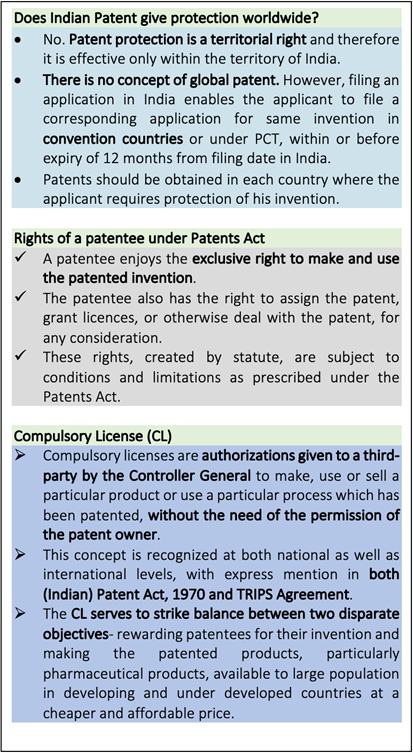
Legal Regime in India
- The patent system in India is governed by the Patents Act, 1970 as amended by the Patents (Amendment) Act, 2005 and the Patents Rules, 2003 as amended in 2016.
- The criteria of patentability:
- It should be novel.
- It should have inventive step or it must be non-obvious
- It should be capable of Industrial application.
- It should not attract the provisions of section 3 and 4 of the Patents Act 1970. Sections 3 and 4 of the Patents Act provides for non-patentable innovations.
- What cannot be patented?
- Frivolous Inventions: an invention which is frivolous or which claims anything obviously contrary to well established natural laws;
- Inventions against public order or morality or which causes harm to the environment.
- The mere discovery of scientific principle or the formulation of an abstract theory or discovery of any living thing or non-living substance occurring in nature. E.g., Newton’s theories and other principles.
- Mere discovery of a new form of a known substance which does not result in enhancement of the known efficacy of that substance.
- According to the Patents Act 1970, there are two types of patents
- The Product patent is the end result or the output produces of a product.
- The Process patent is the journey of a patent being produced.
- g., Paracetamol Tablets can be considered as a product patent while the manufacture of the tablets is the process patent.
- Under the Patent Act, both processes and products are entitled to qualify as inventions if they are new, involve an inventive step, and are capable of industrial application.
Status of Patents in India
- The Patent Office implements the provisions of the Patents Act, 1970 concerning the protection of inventions under the superintendence and administrative control of the Controller general of Patents, Designs and Trademarks (CGPDTM).
- Rising Patent filing and Granted: The number of patents filed in India has gone up from 39,400 in 2010-11 to 58,502 in 2020-21 and the patents granted in India has gone up from 7,509 to 28,391 during the same time period.
- Rising share of Indian residents: The share of Indian residents in total applications has increased from 20% in 2010-11 to around 30% in 2016-17 and 40% in 2020-21.
- Patent in Force: The number of patents in force was 81279 as on March 2020, out of which 12181 patents belonged to Indians.
- India’s ranking in Global Innovation Index has improved from 81st in 2015-16 to 46th in 2021.
Why so Low Patent despite India being a knowledge driven economy?
- Despite a remarkable progress, the number of patents granted in India is still a fraction compared to patents granted in China, USA, Japan, and Korea.
- According to World Intellectual Property Organization (WIPO), the number of patents granted in China, USA, Japan, Korea stood at 5.30 lakh, 3.52 lakh, 1.79 lakh, 1.35 lakh respectively for 2020.
- Key reasons for relatively low patents in India vis-a-vis USA, China etc.
- India’s low expenditure on Research and Development (R&D) activities, which was 0.7% of its GDP in 2020.
- The procedural delays and complexity of the process: The average pendency for final decision in acquiring patents in India is 42 months as of 2020. This is much higher than 20.8, 20, 15.8 and 15 months respectively for USA, China, Korea and Japan.
- Time taken for the first step, i.e. publishing the application by the controller is currently 18 months in India, as compared to 15.4 months in US and 10.2 months in Japan.
- Low number of patent examiners in India: Delay in India’s patent application is also due to the low number of patent examiners in India which was 615 in 2020 as opposed to 13,704 in China, 8,132 in US and 1,666 in Japan.
- No time limit prescribed in the statute for controller to conduct a hearing to determine the validity of responses to the First Examination Report (FER) and any outstanding objections which may not have been adequately addressed by the applicant.
Economic issues raised by patents
Patents have long been considered to represent a trade-off between incentives to innovate on one hand, and competition in the market and diffusion of technology on the other.
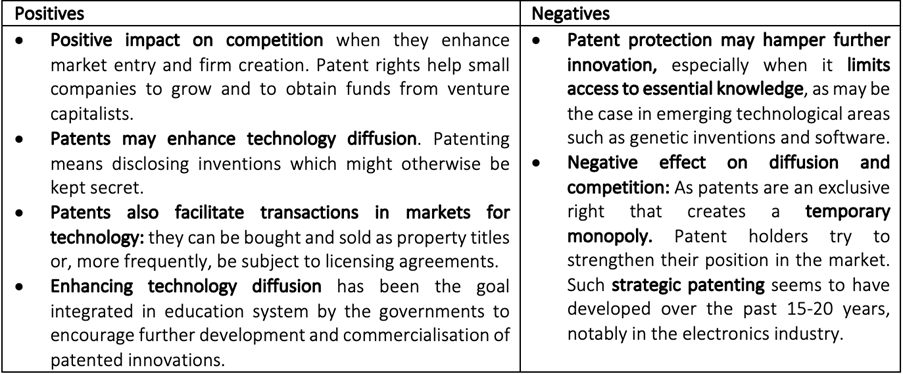
Conclusion and Way Forward
The impact of patents on innovation and economic performance is complex, and fine tuning of patent design is crucial if they are to become an effective policy instrument. India must work on the fronts to address the challenges being faced such as increasing expenditure on R&D activities, increasing the number of patent examiners and a fixed timeline for grant after the opposition hearing. This will drive India’s knowledge-based economy towards innovation and invention.
For article related to this topic, refer to:
Question: Despite a remarkable progress, the number of patents granted in India still lags behind global leaders. What ails India’s invention and patenting regime?
Sources:
- Economic Survey 2021-22 (Chapter 9- Services)
- FREQUENTLY ASKED QUESTIONS: PATENTS
- Annual Reports 2019-20 (Patents Department)
- Patent Law In India - Everything You Must Know
- Innovation and patenting in India and why it’s not among the top 5 yet
- Intellectual property rights in India
- Patents
- Compulsory Licensing In India
- PATENTS AND INNOVATION: TRENDS AND POLICY CHALLENGES
- Compulsory licensing of pharmaceuticals and TRIPS
- Intellectual Property Law in India
- History of Indian Patent System
- Pitfalls of patenting in India
- A patently wrong regime
- India risks being edged out of patent waiver plan at WTO
- India’s patent problems
- India: Challenges faced in the protection and enforcement of patent rights
Army tag for new gecko
This is image of Indian Army’s bent-toed gecko, a species new to science recorded from a forest in Meghalaya. A team of herpetologists have recorded a new species of bent-toed gecko from a wooded part of the Umroi Military Station in Meghalaya. Its scientific name is Crytodactylus exercitus and English name is Indian Army’s bent-toed gecko. Exercitus in Latin means army. The genus Cyrtodactylus is represented by about 320 species worldwide and is the third most speciose vertebrate genus in the world. The members of the genus range from South Asia to Melanesia with high diversity in south Asia. India is now home to 40 species of the bent-toed gecko with the northeast accounting for 16 of them.

Source:
New India Literacy Programme - Edukemy Current Affairs
- Context: The Union government has approved a new scheme “New India Literacy Programme" during the fiscal years 2022-2027, to cover all the aspects of adult education and also to align with national education policy 2020.
- The objectives of the scheme is to impart not only foundational literacy and numeracy but also to cover other components which are necessary for a citizen of 21st century such as critical life skills including financial literacy, digital literacy etc. ; vocational skills development with a view towards obtaining local employment); basic education including preparatory, middle, and secondary stage equivalency.
- The ministry has also decided to use "Education For All" instead of "Adult Education" as the previous term did not appropriately represent all non-literates in 15 years and above age group.
- The scheme will be implemented through volunteerism through online mode. The training, orientation, workshops of volunteers, may also be organised through face-to-face mode.
- All material and resources will be provided digitally for easy access to registered volunteers through easily accessible digital modes. (TV, radio, cell phone-based free/open-source Apps/portals, etc.)
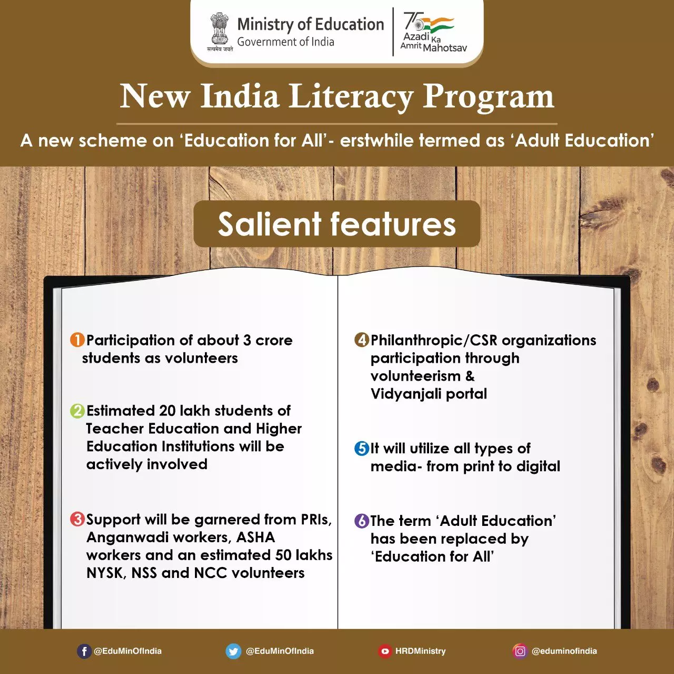
Sources:
Indo-Bangladesh Protocol Route
- Context: The Ministry of Ports, Shipping & Waterways recently flagged off the maiden voyage of barges from Haldia to Pandu ( in Assam) through the Indo-Bangladesh Protocol Route (IBP Route).
- Indo-Bangladesh Protocol on Inland Water Transit & Trade exists between India and Bangladesh under which inland vessels of one country can transit through the specified routes of the other country.
- The existing protocol routes are:
- Kolkata-Pandu-Kolkata
- Kolkata-Karimganj – Kolkata
- Rajshahi-Dhulian-Rajshahi
- Pandu-Karimganj-Pandu
- For inter-country trade, certain ports of call have been designated in each country. These Ports of call generally act as an intermediate stops for a ship on its scheduled journey for unloading and loading of cargo or taking on supplies or fuel and maintenance and refurbishing is carried out.
- This Protocol, which was first signed in the year 1972, was renewed in the year 2015 for a period of five years with a provision for its automatic renewal for a further duration of five years providing long term assurance to various stakeholders.
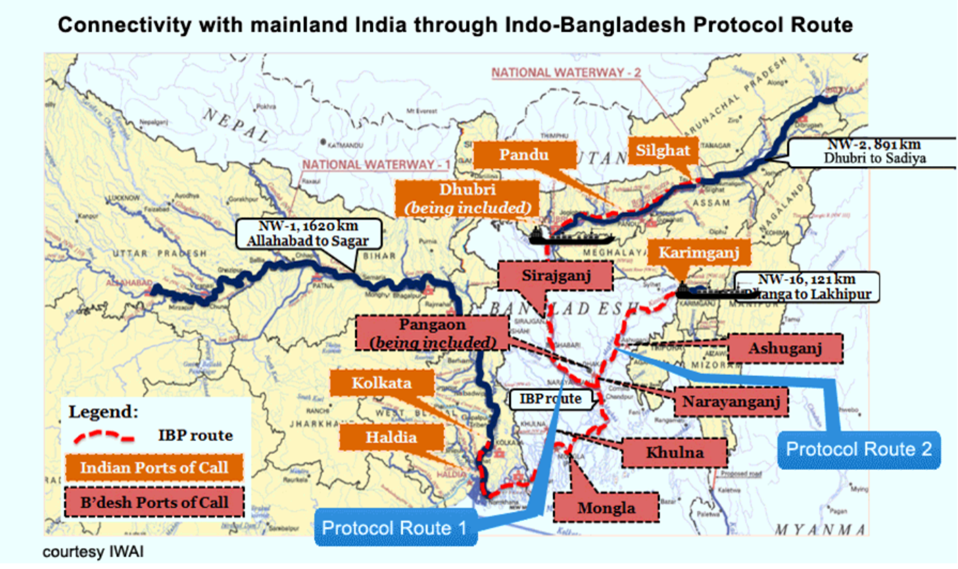
Sources:
President's Fleet Review
- Context: The President of India will attend the 12th President’s Fleet Review of the Indian Navy on 21 February, 2022 in Visakhapatnam.
- Till date, 11 Presidential Fleet Reviews have been conducted since Independence, of which two have been International Fleet Reviews, in 2001 and 2016.
- The fleet review is a long-standing tradition followed by navies all across the world and it is an assembly of ships at a pre-designated place for the purpose of displaying loyalty and allegiance to the sovereign and the state.
- A fleet review is usually conducted once during the tenure of the President.
- The earliest recorded Indian Fleet Review was in the 18th Century by the powerful Maratha fleet, consisting of ‘Ghurabs’ and ‘Gallivats’, under the renowned Sarkhel (Grand Admiral) Kanhoji Angre at the coastal fortress of Ratnagiri.
- Commemorating 75 years of independence, the theme of PFR 22 is ‘Indian Navy – 75 years in Service of the Nation’.

Source:
Atmospheric pressure on Pluto
- Context: A study has revealed that Pluto’s atmospheric pressure on its surface is 80,000 times less than that on Earth.
- The researchers studied the signal-to-noise ratio of the light curves to arrive at the accurate atmospheric pressure of Pluto. The atmospheric pressure of Pluto was found to be 12.23 μbar.
- There is seasonal variability in Pluto’s atmospheric pressure due to the vapour pressure from the nitrogen ice.
- Moreover, the poles of Pluto remain in permanent sunlight or permanent darkness for decades during its 248-year-long orbit around the sun.
- The study also pointed that the occlusion was seen as the dwarf planet is moving away from the galactic plane visible from Earth, making stellar occlusions rarer.
- A stellar occlusion — a phenomenon where the planet coming in front of a bright star is viewed from Earth.

Source:
Weak Investment in Defence R&D: Key Factor Behind India’ Poor Defence Indigenization: ORF
Essence: In the Union Budget 2022-23, only 25% of the total defence R&D budget has been allocated to private sector industries, start-ups and academic institutions. Allocation towards R&D in defence is only 1.7% of the total defence budget. This is small by any standard compared to major military spenders across the world. This explains why India is lagging in building a credible and capable domestic defence industry as our neighbour China spends 9 to 10 percent of their defence budget on defence R&D.
For defence indigenization to pick pace, we need to augment the government R&D spending in defence with private spending. For that to happen private companies must be given tax incentives and treated on par with government funded defence R&D programmes. To compensate for low allocation towards R&D in defence India is promoting FDI by allowing 74% FDI through automatic route in defence sector and guaranteed orders to India private enterprises.
Why should you read this article?
- To know about the key factors behind poor defence indigenisation in India.
- To understand about the non-budget related measures being taken to promote defence indigenisation.
- To know about measures needed to increase private R&D spending in defence sector.
Source:
The imperial roots of the India China row: HT
Essence: The editorial delves into the history and origin of conflicts between India and China over Ladakh region. The Britishers in those times used to demarcate boundaries of territories with the use of nature, the “water-parting principle”, which included the watershed area and river flow as the territory and boundary and presence of mountains to form boundary lines. But using nature as had a serious shortfall. Shifting course of rivers, complex (and not linear) mountain chains, extreme weather and unreachable terrain would not allow for sturdy groundline demarcation. Eg. Aksai Chin region. This region had many border points but only few borderlines, existing at places like Demchok, the flashpoint of clashes. It was used as a border trading town.
The reality of such places is that they were effectively treated as “no man’s land”, devoid of permanent habitation but frequented by traders, pilgrims, and nomadic herders. India inherited the incomplete image of border in British legacy and further border encroachments by China led to a weaker position at border fronts. Shifting boundaries, ambiguity and no consensus over markings have led to further deterioration of international relations. However, the irony of the situation is that these two powerful nations continue to engage valuable resource to control the territory which is of less economic, strategic, or cultural value.
Why should you read this article?
- To understand the history of India China conflicts over Aksai Chin and its causes.
- To know the significance of border areas and the techniques for their demarcation during British times.
Source:
Barefoot Scientist
Background
Abdul Khadar Nadakattin popularly known as ‘Hunase Huccha’ from Dharwad, Karnataka is the brain behind multiple inventions and innovations in the field of agriculture.
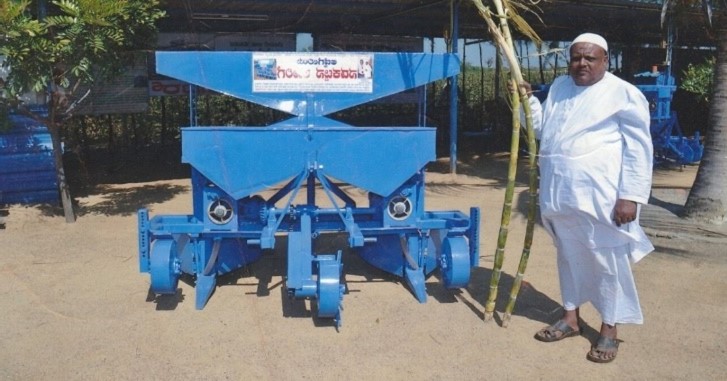
Inventions under the name of ‘Hunase Huccha’
- Abdul had to drop schooling due to financial constraints. But, his innovative mind had managed to design a water alarm at the age of 14 itself.
- When his family passed the ancestral farm land to him, he learnt about the difficulties in agriculture. So, a series of innovative tools/machines were invented by him for ease in farming.
- Apart from his innovative pursuit of helping farmers, Abdul also worked to improve the agricultural yield on his farm.
- He made a total of 24 inventions till date, which aim to resolve day-to day issues of the farmers.
- Some of the important innovations include: tamarind de-seeder, tiller machines, plough blades, seed-cum-fertiliser drill, automated sugarcane sowing machine, etc.
- All the machines and equipment are sold at low cost compared to the market price to benefit the farmers.
- He received President’s Lifetime Achievement Award in 2015 and the Padma Shri in 2022 for his never-ending determination and zeal to help the farming community.
Quote: “The inventor ... looks upon the world and is not contented with things as they are. He wants to improve whatever he sees, he wants to benefit the world; he is haunted by an idea. The spirit of invention possesses him, seeking materialization.”-ALEXANDER GRAHAM BELL
Source:
Share the article
Get Latest Updates on Offers, Event dates, and free Mentorship sessions.

Get in touch with our Expert Academic Counsellors 👋
FAQs
UPSC Daily Current Affairs focuses on learning current events on a daily basis. An aspirant needs to study regular and updated information about current events, news, and relevant topics that are important for UPSC aspirants. It covers national and international affairs, government policies, socio-economic issues, science and technology advancements, and more.
UPSC Daily Current Affairs provides aspirants with a concise and comprehensive overview of the latest happenings and developments across various fields. It helps aspirants stay updated with current affairs and provides them with valuable insights and analysis, which are essential for answering questions in the UPSC examinations. It enhances their knowledge, analytical skills, and ability to connect current affairs with the UPSC syllabus.
UPSC Daily Current Affairs covers a wide range of topics, including politics, economics, science and technology, environment, social issues, governance, international relations, and more. It offers news summaries, in-depth analyses, editorials, opinion pieces, and relevant study materials. It also provides practice questions and quizzes to help aspirants test their understanding of current affairs.
Edukemy's UPSC Daily Current Affairs can be accessed through:
- UPSC Daily Current Affairs can be accessed through Current Affairs tab at the top of the Main Page of Edukemy.
- Edukemy Mobile app: The Daily Current Affairs can also be access through Edukemy Mobile App.
- Social media: Follow Edukemy’s official social media accounts or pages that provide UPSC Daily Current Affairs updates, including Facebook, Twitter, or Telegram channels.

